OTHER EVIDENCE SUPPORTING THE LOST TRIBES WITHIN AMERICA
Exhibit A - The ancient Great Lakes Map
Reportedly found in the American mid-west, this ancient map of the Great Lakes (to the right) depicts exploration routes in the form of dotted lines (8). In the upper right-hand corner, notice where the route originates—the St. Lawrence River. Then the trail continues around the lakes terminating below Lake Michigan southward into the Ohio Valley.

Was this map made by the Khumry people showing their migration route? Entirely possible, I’d say.
My contention is the
Khumry people were the mysterious “mound-builders” that flourished within this
valley and inter-married with the Cherokee long ago. They constructed the famous
“Serpent mound” in which I also believe to be a replica of the Destroyer. See ![]() Planet X and the Kolbrin Bible Connection
Planet X and the Kolbrin Bible Connection
Furthermore my investigation affirms that the same Khumry mound-builders of the British Isles migrated to America and continued their construction process within the Ohio valley region.
As with Jeremiah’s tomb in Ireland, the same mound-building technique was used for burials in Ohio as well. It’s not surprising then to find an interesting ‘Khumric’ artefact discovered inside one of these similar construction-style burial mounds in Newark Ohio. See below:
Exhibit-B - The Decalogue Stone
“In November of 1860, David Wyrick of Newark, Ohio found an inscribed stone in a burial mound about 10 miles south of Newark. The stone is inscribed on all sides with a condensed version of the Ten Commandments or Decalogue, in a peculiar form of post-Exilic square Hebrew letters.

The robed and bearded figure on the front is identified as Moses in letters fanning over his head. The inscription is carved into a fine-grained black stone...(9)
Exhibit C - The Bat Creek Stone
“The Bat Creek Stone was professionally excavated in 1889 from an undisturbed burial mound in Eastern Tennessee by the Smithsonian's Mound Survey project... Hebrew scholar and archaeologist Robert Stieglitz (1976) confirmed...the main line [to] read RQ , LYHWD[M], i.e. “Only for Judea,” or “Only for the Judeans” if the broken letter is included.

In 2002, researchers Alan Wilson, Baram A. Blackett, and Jim Michael announced that the Bat Creek stone is in fact inscribed with the the ancient Welsh Coelbren alphabet, and reads, in Welsh, “Madoc the ruler he is.” These authors identify the Bat Creek tumulus as “the likely tomb of Prince Madoc.”
Madoc was a Welsh prince who is reputed to have sailed to America in 1170 A.D. However, Wilson [and Blackett] maintain that he was in fact a brother of King Arthur II, and sailed in 562 A.D. This would reconcile their reading of the inscription with the C-14 date of 32 A.D. - 769 A.D....If the Bat Creek stone, which was professionally excavated and whose context been carbon-dated to ancient times, were clearly engraved in Coelbren letters, that would itself be sufficient to vindicate the authenticity of Coelbren...” (10)
Exhibit D - The Coelbren Sword
Glenn Kimball writes “Several decades ago a sword from the sixth century... was found in Pennsylvania. This sword was featured in the book "Holy Kingdom" by Adrian Gilbert from England and his research team. Adrian suggested that it [looks]...very [similar] to the sword Excalibur...Written on the blade of this sword is the word "Colbrin" or "Kolbrin"...

"According to Adrian Gilbert, “Alan Wilson had made two long visits to the USA in 1992 and 1994 cooperating with USA colleagues on the transatlantic voyages of AD 562... Welsh Coelbren Alphabet inscriptions exist in large numbers in North America proving these voyages.” (2)
Exhibit E – Engraved Shell Gorget
Found in the state of Mississippi circa 1883, the engraved shell gorget shown above (11) depicts what I believe to be the Destroyer (Nibiru) or the Crossed Planet. Notice the sun-like appearance around the circular edge itself. Now compare that to the ‘Mithras’ iconic symbol below supplied by Andy Lloyd in our Sol and Mithras web-page (12).
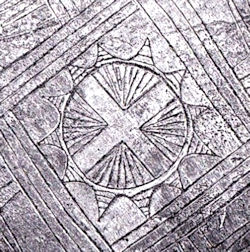
The resemblance is striking to say the least. In my opinion, it is the same crossed planet in both pictures—Nibiru.
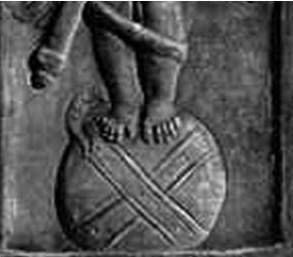
The map provided below is a recap of possible Khumry migration routes with corresponding artefacts found: (13)
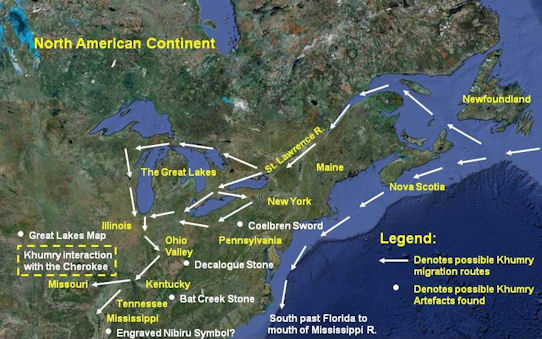
PRESERVATION OF THE KHUMRIC RECORDS
Another reason I maintain the Kolbrin MS to be authentic is the fact that an extraordinary amount of detail was painstakingly recorded on how to preserve the Khumric scrolls. If all of this was an outright fake, why bother to write any of this exquisite detail down in the first place! As I read these passages, I get the impression the scrolls were prepared for a deep burial near water so they could not be found easily. Oak Island perhaps in Nova Scotia? I can only speculate. See below:
‘SOF:24:1...Last of the Metal Plates...In the containers I have gathered together all the books given into my care and I have done all the things I was instructed to do, and the work of my father is now complete. The metal will stand the test of age and the cutting is the finest workmanship.
SOF:24:2 The five great bookboxes contain one hundred and thirty-two scrolls and five ring-bound volumes. There are sixty-two thousand four hundred and eighty three words in The Greater Book of the Egyptians and eighty-one thousand six hundred and twenty-six words in The Lesser Book of The Egyptians, of which eight thousand nine hundred and eleven are in The Book of The Trial of The Great God and six thousand one hundred and thirty-four are in The Sacred Register, and sixteen thousand and fifty-six are in The Book of Establishment.
SOF:24:3 The Book of Magical Concoctions has six thousand eight hundred and ten words and this was the most difficult to remit, for it was a work of mystery and hidden things.
SOF:24:4 The Book of Songs and The Book of Creation and Destruction were not worked under my hand, but they are well constituted and will not perish. The Book of Tribulation was beaten under my eye and there are the books in The Great Book of The Sons of Fire which are not of my workmanship. I helped in part where the words were marked out and I struck them.
SOF:24:5 The Book of Secret Lore and The Book of Decrees are joined into The Great Book of The Sons of Fire and they, too, are enabled to last forever.
SOF:24:6 The metal is as our masters desired, made cunningly by the secret methods of our tribe and it will never perish. The marks are cut so that when seen to the right of the light they stand out clearly.
SOF:24:7 The bookboxes are of twinmetal founded with strength and turned with great heat, so that there is no joint where the ends come together. When closed and sealed water cannot enter.
SOF:24:8 When you read these things in times ahead, think of us who made the metal so imperishable and cut the words on it with such care and heavy labour, using such skill that in the years of rest they have not been eaten off. Observe its brightness and wonder, for it will never tarnish.
SOF:24:9 We are the sons of The Sons of Fire, men so called because fire was necessary to their metalworking. Today we name our sons over the fire and forge, as they did, and each one of us belongs to the same fire.
SOF:24:10 Read carefully the sacred words which are written and may they be a lodemark to a greater life.
SOF:24:11 I, Efantiglan, and my father, attended to the making of these books and their covering containers. Those who mixed the metal and worked it by forging and those who cut upon it are members of our tribe, and it is well made and will last forever.
SOF:24:12 Malgwin recorded these books before they were consigned to the future and the name by which they were called is The Living Book For The Living’.” (1)
CONCLUSION
Throughout the Kolbrin MS the message remains the same. The Khumry (writing in their ancient Coelbren alphabet) warn us of a returning monstrous planet. As I’ve stated before, it really is the Rosetta Stone, the Holy Grail if-you-will of all ancient texts supporting this fact. Why then was this manuscript released to the public in 1992? Well, the following passage might explain this question:
MAN:3:9… the hour of the DESTROYER is at hand. MAN:3:10 In those days, men will have the GREAT BOOK before them, wisdom will be revealed, the few will be gathered for the stand, it is the hour of trial. The dauntless ones will survive, the stouthearted will not go down to destruction.
Ever since the Khumry scattering, the ‘elite’ families of the world have known about this incoming celestial event. And it is my belief they released the “Great Book” to the general public so we could also be privy to the warning. Even if you do not believe in any of this, the elite families do. So take heed when I say the Destroyer was a fact known to the Lost Tribes of Israel, a fact the Wanderers eventually brought to America. Today we know it as Planet X, the Greeks knew it as Phaeton, the Khumry people knew it as the Frightener and the Sumerians knew it as Nibiru.
References
(1) Marshall Masters "The Kolbrin Bible 21st Century Master Edition" Your Own World, Inc., 2006
(8) Ancient Great Lakes Map (c) 2006 John J. White III, Ancient Science and Technology Center, Midwestern Epigraphic Society, Columbus Ohio.
(9) "The Newark, Ohio Decalogue Stone and Keystone" With thanks to J. Huston McCulloch.
(10) J. Huston McCulloch "The Bat Creek Stone" Sept. 2010
(11) George R. Milner "The Moundbuilders" Thames and Hudson, 2004
(12) Greg Jenner & Andy Lloyd "Sol and Mithras" with thanks to Andy Lloyd.
darkstar1.co.uk/gregjenner18.html
(13) Greg Jenner Map of the Khumry migration routes to North America, Jan. 2011,
Written by Greg Jenner, 2011, author of
![]() Planet X and the Kolbrin Bible Connection
Planet X and the Kolbrin Bible Connection
A research note about the Kolbrin, by Andy Lloyd
Greg makes an excellent case for textual references about the Dark Star as the Kolbrin's Destroyer. This is tantalising material to say the least. So what is the Kolbrin, and what scholarly work can we delve into to get more answers as to the origins of these remarkable writings?
Looking up Kolbrin on Google simply brings up the material offered by the publishers of the Kolbrin Bible. As noted by Greg, the claim is made that the work dates back to the 12th Century. However, this claim does not reflect more general opinion about the origin of the work. The word 'Kolbrin' turns out to be a distortion of the original Welsh Coelbren. Here's a wikipedia entry about Edward Williams (bardic name Iolo Morganwg), who is said to have created the work in the 18th century as part of his widely acknowledged attempts to manufacture ancient druidic works for commercial gain:
Iolo Morganwg developed his own runic system, in Welsh Coelbren y Beirdd ("the Bardic Alphabet"). It was said to be the alphabetic system of the ancient druids. It consisted of 20 main letters, and 20 others "to represent elongated vowels and mutations." These symbols were to be represented in a wooden frame, known as peithynen.
(Ref: http://en.wikipedia.org/wiki/Iolo_Morganwg)
A kinder interpretation of his creation of the Coelbren is this:
It may well be that it was he who devised the system to fill the gap in Celtic literacy that he felt existed but had been lost. This is usually the interpretation favoured by those who think that the Coelbren are contrived and to explain the lack of any physical evidence that they existed before this point. Even so, this does not alter the fact that since Iolo's time the system has been in more or less continuous use and has now developed a considerable heritage in the process.
(Ref: druidry.org Article no longer available online)
One can already sense problems. Academics do not appear to be involved in work on the Coelbren. Which probably means that they consider it to be a clever fake, albeit one that has become something of a Welsh cultural treasure.
Next we turn our attention to the various myths that swirl around Glastonbury, and the alleged visit there by Joseph of Arimethea. These hardly seems credible to modern eyes, but were certainly taken seriously during mediaeval times. The question in my mind is whether the mediaeval myths can be properly positioned alongside the creation of the Coelbren centuries later. Was the Coelbren a reproduction of ancient material passed down secretly through many generations eager to avoid the attention of pious clerics and, later, witch-hunters? We find ourselves immersed in a more general argument about the transmission of ancient wisdom through the many dark centuries of intellectual prohibition.
Let's look beyond such murky considerations. How about the context of how this work fits into modern academia? Much of the Kolbrin deals with an Egyptian account of the Exodus - which would be startling if authenticated, because it would provide an alternative piece of evidence that the Exodus even took place at all. Biblical scholarship has difficulties with the Exodus as an historical event. There are many competing theories, and if the Kolbrin was accepted by scholars as an authentic work then it would surely become part of that monumental academic argument.
So, how about the Masonic connection? There are certainly druidic orders in Britain, which are quasi-Masonic in character. They don't fall into the standardised set of Masonic orders. According to my book on British Freemasonry by Masonic Grand Master Michael Stayt (The Rungs of the Ladder, 1999), they are 'non-Masonic, but designed to extend Masonic thought'. Their content is largely mystical and intended for Freemasons wishing to further develop their spiritual understanding. Whether the Coelbren is featured in their lore I couldn't say.
That's not to say, however, that Freemasons belonging to the more traditional orders weren't involved in the guarding of such a work, and its eventual transmission. It would be useful if such individuals were able to make their stories public as a way of authenticating how this controversial work came into the public domain in the early 1990s.
Written by Andy Lloyd, 15th September 2009
The Coelbren Alphabet, by Greg Jenner
Hi Andy,
To shed more light on the Coelbren alphabet authenticity, provided below is my
contribution to James Leslie's (Ret.) MES Newsletter, Vol.
34 No.2, May 2017:
"In light of the Coelbren script discovered in southern Utah by Steve Shaffer
and interpreted by Michael Boutet, I feel compelled to chime in here.
First off, I believe the Coelbren to be a legitimate alphabet. According to
[Researchers] Wilson and Blackett, Dafydd ap Gwilym mentioned the alphabet
before he died in 1367. And William Owen (1790-1815) published the entire
Coelbren alphabet gleaned from ancient times. All this occurred before Edward
Williams (Iolo Morganwg) was said to have invented the alphabet near the turn of
the 1800’s.
Secondly, Welsh children were taught this alphabet from the use of school charts
depicting the language. See example here:
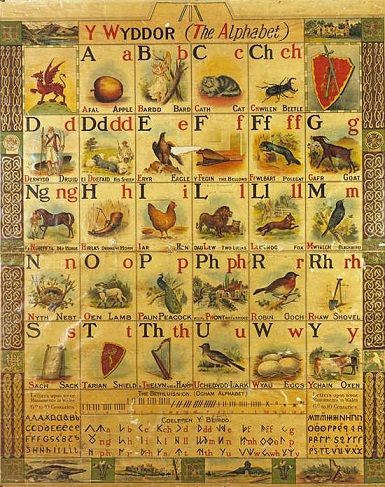
And thirdly, the Coelbren’s meaning was actually in Welsh dictionaries many years ago. This example from 1803. Stating, “This was the original alphabet of the Britons.”
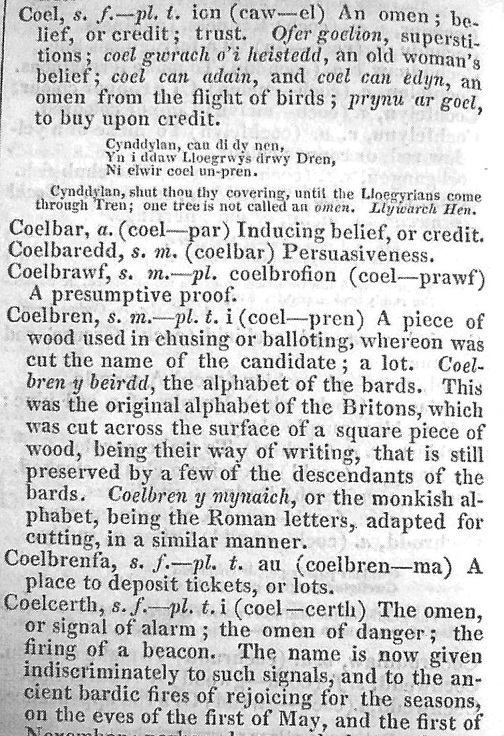
Keep in mind the original Britons were not
Anglo-Saxon. (I can only speculate that this might have had something to do with
the perplexing animosity toward the alphabet).
The 1803 dictionary goes on to say, “Coelbren y mynaich, or the monkish
alphabet, being of Roman letters, [was] adapted for cutting in a similar
manner.” So the Welsh Monks had their own version of the Coelbren! A Welsh Monk
cipher perhaps?
Let’s say, for argument sake, the Coelbren was indeed made up and invented. Does
that mean Welsh history, written down in Coelbren by Welsh school children,
would become null and void and struck from the record? Of course not! Writing in
Coelbren would be a legitimate practice for the Welsh children, especially if
that was the only alphabet they were exposed to when they were young. I guess
what I’m trying to say here is we simply cannot throw the Coelbren alphabet out
with the bathwater. We can derive legitimate information from this alphabet.
So, yes, researchers can interpret and glean factual based knowledge from a
particular alphabet, even if it’s made up. After all, isn’t that why ancient
monks and [clandestine] groups used ‘invented’ ciphers and short-hand in the
first place? To carry forward and hide factual based information.
Another point I would like to stress here is that Iolo Morganwg was demonized by
academia for being high on opium whilst supposedly inventing the Coelbren
alphabet, along with his Barddas volumes. This doesn’t hold much weight for me
either. Can you honestly say, in all the history of Latin writing, a fellow
scribe could not have easily been high or drunk on too much wine from producing
a manuscript? It was a very dull and tedious process. Sorry academia, nice try.
[As I've stated in the past] A great place to find a wealth of hidden history is
from the Kolbrin MS where, I believe, at least one account was recorded by the
Khumry (Welsh descendants) sailing over to North America, well before Columbus.
The Khumry used a form of Ogham as well, which tells us the Celts were also in
the fray."
Greg Jenner, 2017


